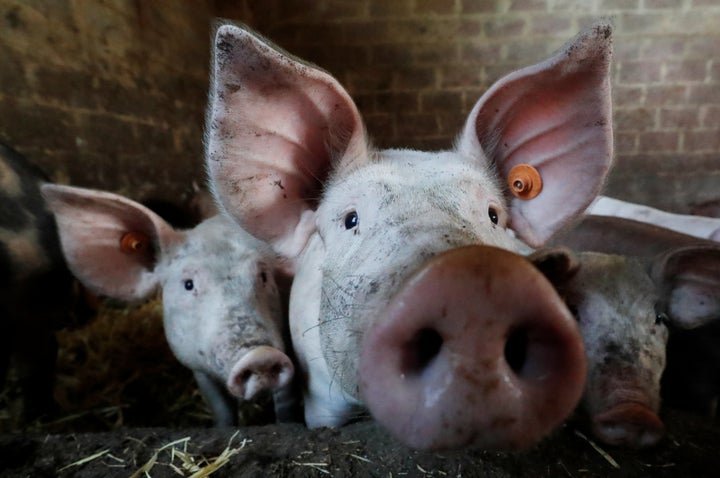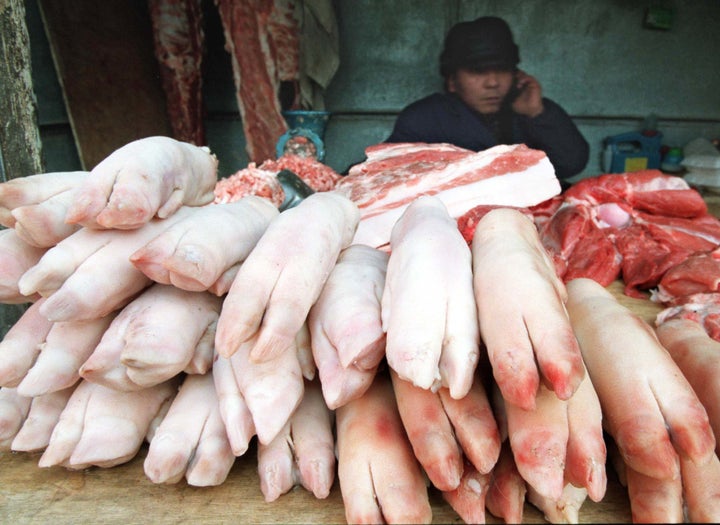
Kate Morgan had not intended to get involved in her family’s pig farm in Yorkshire in the northeast of England. But, returning home after growing bored of her office job, the 34-year-old became determined to help seek new opportunities for the farm business her parents had started from scratch in the mid-1990s.
That opportunity came three years ago when the family was approached by a pork processor looking for antibiotic-free meat to sell to a growing customer base in the U.S. The farm’s commitment to pig health ― and therefore fewer illnesses among its animals ― meant it already minimized its use of antibiotics, so, with the help of a premium for the drug-free pork, they eliminated them altogether from the 1,200 breeding pigs they rear outdoors. All the antibiotic-free pigs are sold to Karro Foods and exported to customers in America, including fast-food chain Chipotle.
In the U.S., 60 percent of all the antibiotics farm animals consume are medically important, meaning they are also used in human medicine. Aside from treating illness, farmers use antibiotics for various reasons.
Some use them as a prophylactic, to prevent animals from getting diseases in the first place. This is particularly appealing for farms that keep animals in enclosed, cramped spaces, which provide the perfect conditions for the spread of disease. In 2017, the U.S. Food and Drug Administration issued guidance that human antibiotics should not be used purely as a growth stimulator, although there is evidence antibiotics are still being used to fatten up livestock.

Farming’s high use of antibiotics is bad news for human medicine. Overuse and misuse is contributing to the development of antimicrobial-resistant bacteria, which can be transmitted to humans via direct contact with animals, through the food chain, or through the environment. This is leading to fears of a post-antibiotic era where humans are unable to treat some common infections. Already today, an estimated 700,000 people worldwide die from drug-resistant infections. By 2050, some experts have predicted, antibiotic resistance could claim 10 million lives and cost up to $100 trillion.
The World Health Organization has called for an end to the use of antibiotics in healthy animals. But the U.S. government has pushed back, calling WHO’s science into question. And although increasing demand from U.S. consumers for meat raised without antibiotics is encouraging farmers like Morgan to change, global health academics have said the U.S. reliance on market-led change means progress is still slow.
Morgan hasn’t yet cut out antibiotic use entirely on the 1,700 pigs she breeds indoors as that meat is sold in the U.K. where, she says, there isn’t such strong consumer demand. Part of the reason is that the U.K. pig sector doesn’t use as many antibiotics. Per kilogram of animal, the U.K. uses just over half the amount the U.S. does, according to the Natural Resources Defense Council, an environmental nonprofit.
“The reason some pork producers struggle [to reduce antibiotic use] in the U.S. is that they are so densely populated in terms of herds, making them susceptible to infection from neighboring farms,” said Morgan, who spent time researching antibiotic use on pig farms in the U.S. and Europe before making changes on her own farm.
In the U.S., consumer concern about farm antibiotic use has already helped to instigate a major shift away from the use of drugs in the chicken sector. About half of all chicken producers in the U.S. are estimated to be actively reducing antibiotic use, and a number of major fast-food outlets, including McDonald’s, KFC, Taco Bell, Burger King, Chipotle, Pizza Hut and Subway, are implementing stricter policies about antibiotics in the meat they serve.

The change is already having a positive effect, with U.S. officials reporting that sales and distribution of medically important antibiotics for food production in the U.S. fell 14 percent from 2015 to 2016, the first decline since the agency began collecting data in 2009.
Despite progress in the chicken sector, the U.S. has a long way to go. Progress has not been as quick in the beef and pork sectors, according to a report by the NRDC. Lena Brook, food director at the NRDC, says this is partly because pigs and cows live longer, making it harder to avoid illness and the need for antibiotics.
However, Brook says U.S. farmers can find solutions for reducing antibiotic use, pointing to practices in major pork-producing countries like Denmark and the Netherlands. The U.S. uses more than seven times as many medically important drugs per kilogram of pork produced than those countries. Farmers there employ a number of commonsense measures to reduce disease risk, such as frequent housecleaning, reduced animal densities and improved diets. “We don’t need to reinvent the wheel,” Brook said.
To successfully tackle the problem requires worldwide change. Global antibiotic use is predicted to rise by 67 percent between 2010 and 2030, and nearly double in countries such as China, India, Brazil and Russia, driven by an increase in consumer demand for meat and dairy, and a shift to large-scale, industrial farms where antibiotics are used routinely.

Without global solutions, say infectious disease specialists, drug resistance will be spread around the world by livestock and human population movements, negating progress by countries.
One solution could be a tax on antibiotic use to deter all but critical use in livestock, or alternatively, individual countries could use trade as a bargaining tool to force action.
The European Union has already said that it wants any countries exporting animal products into the bloc to meet its own rules on antibiotics, which include a ban on the use of antibiotics as growth-promoters and stronger limits on prophylactic use. In the U.S., Thomas Gremillion, director of food policy at the Consumer Federation of America, says the government needs to start setting tougher goals for reducing farm use of antibiotics.
“We need to start collecting data on what farmers are using, define goals and set targets. That’s what successful countries are doing,” Gremillion said.
Ultimately, it’s not about necessarily eliminating all use of antibiotics in farming, said Brook, but limiting it to only essential times. “It’s OK to treat animals with antibiotics. It doesn’t need to be ‘no antibiotics ever’ to be a good farming system. We want to normalize the responsible use of antibiotics so that all producers are reducing usage. That’s where we need policy in place,” she said.
For more content and to be part of the “This New World” community, follow our Facebook page.
HuffPost’s “This New World” series is funded by Partners for a New Economy and the Kendeda Fund. All content is editorially independent, with no influence or input from the foundations. If you have an idea or tip for the editorial series, send an email to thisnewworld@huffpost.com
